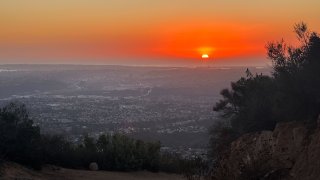
San Diegans, we have officially passed the threshold of the end of daylight saving time (more on why we are still changing our clocks for DST here) and have descended into the darkness of standard time.
If you've caught yourself in awe of how quickly the sun goes down now, get used to it! Our skies will get progressively darker until the winter solstice next month, when the days begin growing longer.
BUT that also means our famously gorgeous sunsets are arriving earlier. (Got amazing sunset pictures? We'd love to see! Send them to isee@nbcsandiego.com or upload them here.)
While the time switch remains unpopular, why shouldn't San Diegans take advantage of this season's early sunsets?
Get San Diego local news, weather forecasts, sports and lifestyle stories to your inbox. Sign up for NBC San Diego newsletters.
Here's a guide on doing just that.
Standard time sunsets in San Diego
San Diegans, enjoy what sun you can get by catching these sunrise and sunset times below!
Local
On Nov. 7, the sun will set in stunning San Diego at 4:53 p.m., according to the National Oceanic and Atmospheric Administration.
On Nov. 14, the sun will set at 4:48 p.m. in San Diego.
Catch our earliest sunset on Nov. 30 at 4:42 p.m., but that's not our shortest day of the year.
The shortest day of the year will occur on Dec. 21, when the sun will rise at 6:47 a.m. and set at 4:47 p.m. San Diegans will get exactly 10 hours of sunlight that day.
On Thanksgiving Day (Nov. 23) San Diegans can take a break from all the turkey and catch a 4:44 p.m. sunset.
The winter solstice: The shortest day of the year
The day of the year with the least amount of daylight is also known as the winter solstice. This year, the winter solstice occurs on Thursday, Dec. 21 at 7:27 p.m. PST.
For us Northern Hemisphere dwellers, it's also known as the first day of winter.
"On the day of the winter solstice, we are tilted as far away from the Sun as possible, which means that the Sun’s path across the sky is as low in the sky as it can be," according to the Farmer's Almanac.
"Think about the daily path of the Sun: It rises in the east and sets in the west, arcing across the sky overhead. During the summer, the Sun arcs high in the sky, but during the winter, it arcs lower, closer to the horizon," according to the Farmer's Almanac.
During this season, the sun moves towards its most southerly point in the sky, which occurs on the day of the solstice. The day just after the winter solstice, the sun begins moving back northward towards its most northerly point, which occurs on the day of the summer solstice (the longest day of the year), according to the Farmer's Almanac.
When do we turn the clocks back to daylight saving time?
Daylight saving time will resume on March 10, 2024, which is the second Sunday in March. By that time, we'll be getting a lot more hours of daylight.



